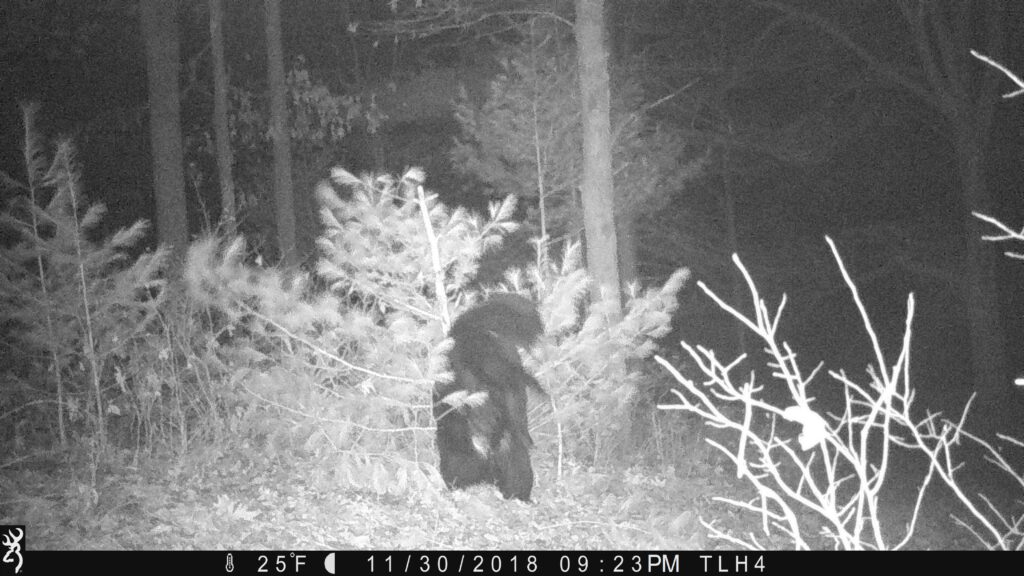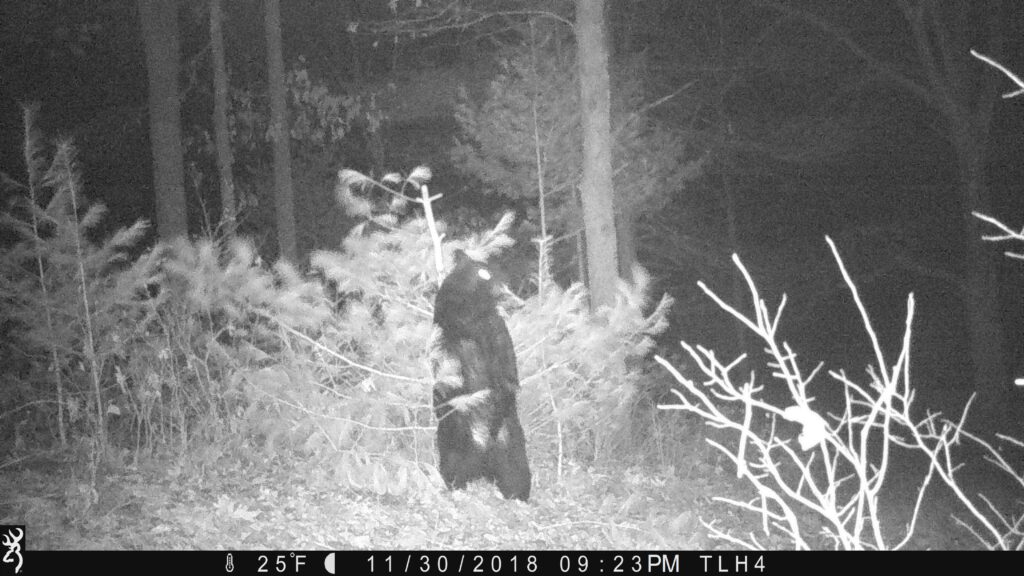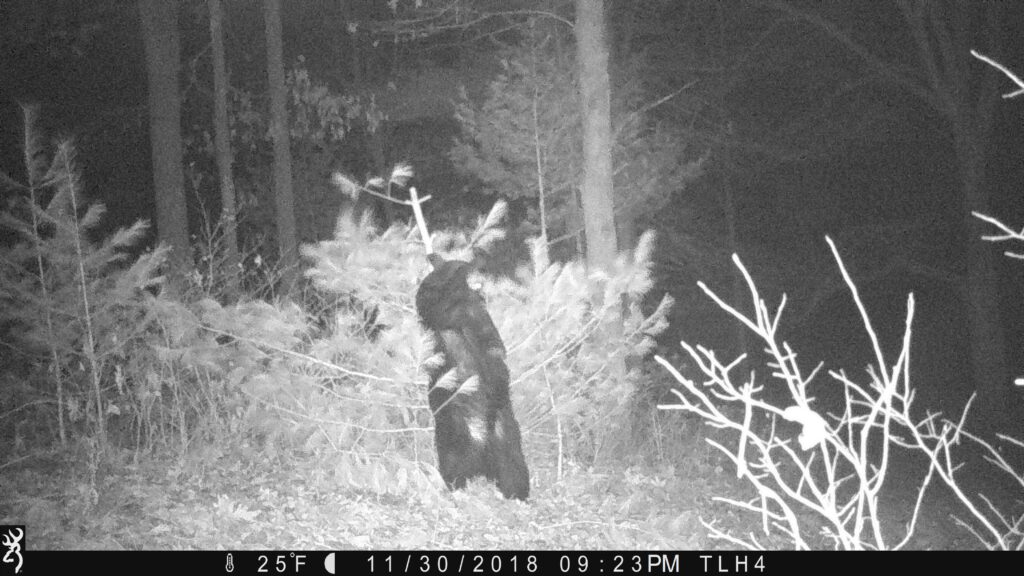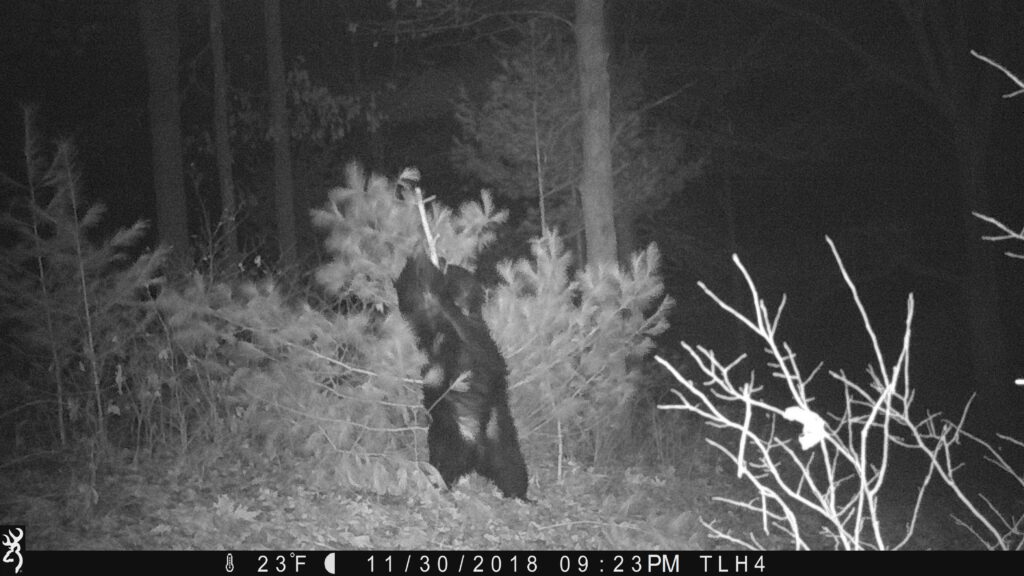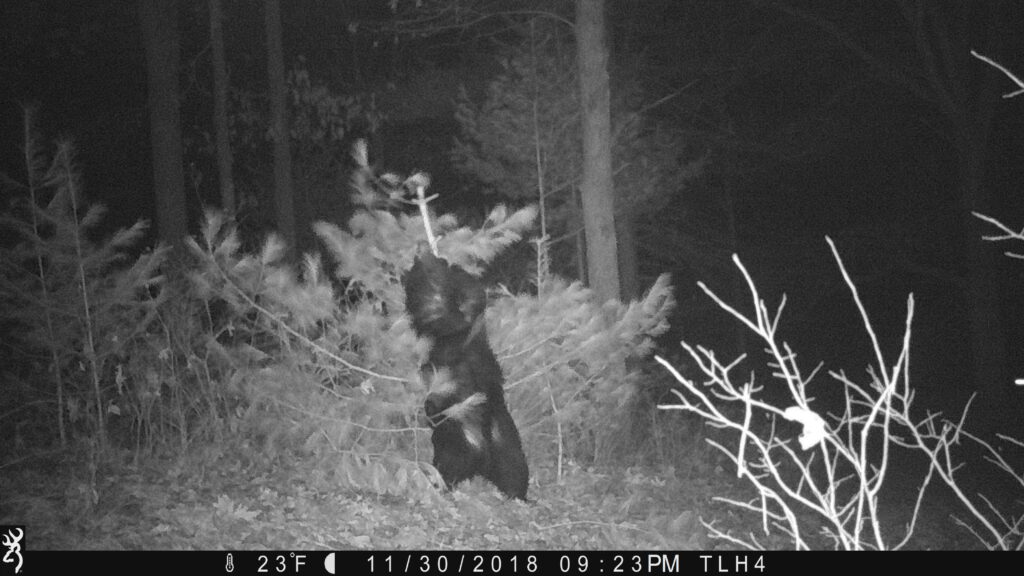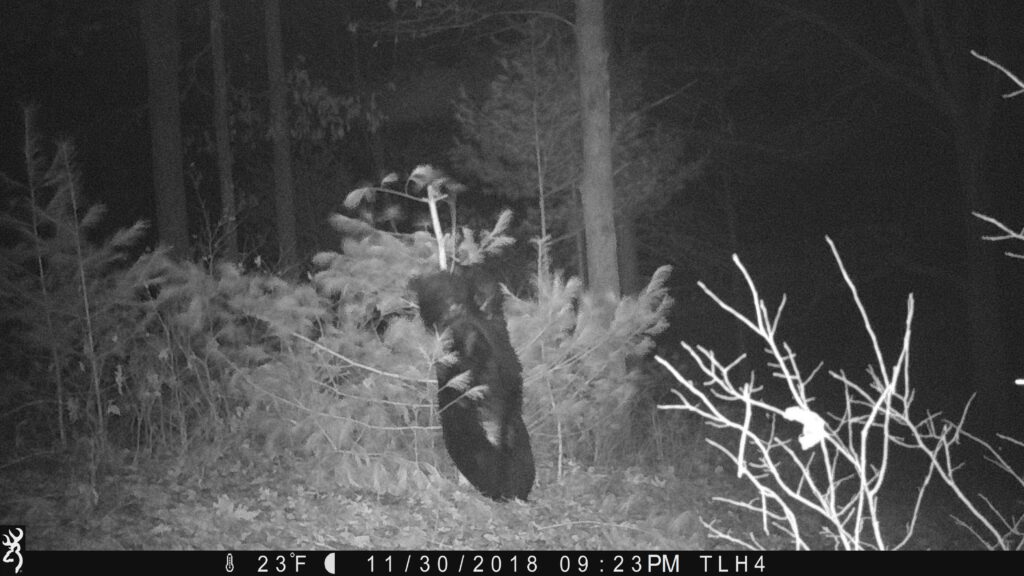Posts Tagged → bear
Reflections on 2020 bear season
As if by magic or just the batting of an eyelid, the much anticipated 2020 bear season is now behind us, having concluded at dark yesterday. Sad to see our friends go; we had such a fun time! The last of our bear hunting guests have left, cleanup has commenced, preparations are under way for Thanksgiving, and there are some reflections to be had on bear season.
First, where the hell were the bears? Serious question here. We hunt in a mountainous Northcentral area that is Pennsylvania’s “Bear Central.” And despite us daily scouring a lot of remote, very rugged territory that is usually home to lots of bears, we saw neither bears nor bear poop. None. It could be the warm weather has bears hunkered down under cool overhangs in even more remote places. It could be the low acorn crop has bears going in to hibernation early, because there is no more food for them to eat to put on the extra fat they need to hibernate successfully. The truth is, no bear tracks or poops have been seen around here for months, which is remarkable. I cannot think of any year prior like this.
Second, where were all the hunters? We heard only a few shots between Saturday and Sunday, and either none or one on Monday, and for sure none on Tuesday; and very few hunting parties were on the radio on any day. This means that few large scale hunting drives were going on. Without hunters moving across the landscape, the bears don’t have to move out of their way. They can just sit still and not run the risk of exposing their rib cage to a hunter’s bullet. That means that the bears can loaf about in some remote corner, escaping the unseasonable warmth or just waiting for the wafting human scent to drift away before making their usual rounds again. Which means the few hunters who are out don’t see much action.
Third, where were all the other critters, like turkeys and deer? Like with bears, we saw very little deer or turkey poop in the woods. And although I myself saw two whopper bucks and a five-point up close, no one else saw any deer. Nor did any of us see any turkeys. Once again, the absence of these otherwise ubiquitous animals could be due to the relative absence of acorns. Which would push the wildlife far afield to find food sources.
Fourth, despite all of our hunting setbacks, did any of us care a bit? No! We missed all of our friends who could not be with us for various reasons, like fear of the CCP virus, or family emergencies requiring them to stay at home. But those of us who gathered had a lot of fun nonetheless. And with or without a bear on the game pole, we would not have missed this time together for any reason at all. We caught up on our families, our work, our homes, cars, friendships, wives, and politics (yeah, there was a lot of pro-Trump politics). Some people drank way too much alcohol, and we got some great pictures of it all, like the one guy asleep on the cold ground outside. No, we don’t post those here. We ate like kings, that is for sure, and no one lacked for food or drink.
Finally, it is possible that the new early bears seasons (archery, muzzleloader, and special junior+ senior rifle) are removing so many bears from the woods that come rifle season, very few huntable bears remain to be had. According to real-time hunting harvest data posted at the PA Game Commission website, more bears were killed in the early seasons than in the official rifle season this year. This means there are fewer bears available for the rifle hunters. It is possible that many hunters expected this, based on last year’s harvest patterns, and they stayed home or hunted alone, instead of joining the big crew at camp, like usual. As of late today, just 3,138 bears had been killed total this year. That is about a thousand fewer than expected.
Based on this raw data alone, the early bear seasons are actually backfiring. They are not removing the high surplus number of bears that are beyond Pennsylvania’s social carrying capacity. Rather, the early bear seasons are removing the easiest bears and leaving few to be hunted in the later rifle season.
And this new dynamic could be the real story in PA’s bear season: There are so many early season bear hunting opportunities for individuals that they collectively take the wind out of the sails for the regular season hunters, thereby having a boomerang effect on the entire thing and limiting it.
We won’t know what all this data really means for another few years, and by then either great or even fatal damage will have been done to Pennsylvania’s traditional bear camp culture, with its big gatherings and big drives and big camp camaraderie dying out, or we will simply all have to learn to adapt to new ways of hunting. I have to say, there is no substitute for men gathering at a camp to hunt together. The gathered hunting party is the most human of experiences; it is an institution as old as our species. Its purpose was not just making meat, but also social and sociological.
I sure hope these myriad new early bear seasons are not self-defeating, in that they do not kill that traditional bear camp culture by removing its whole purpose ahead of the game. Question for the PGC: What incentive is there to push your body hard through rugged and remote landscapes, destroying your boots, tearing your clothing, and often losing or breaking some of your gear, including damaging your gun, when the animal you are seeking has already been removed?
Below are some photos from one of our trail cameras two years ago. Just days after bear season ended, a bear was caught gloriously and most joyously rubbing its back against a young white pine tree. Almost like a pole dancer. Pretty hot hip shakes there. We haven’t seen a bear anywhere around here since May this year.
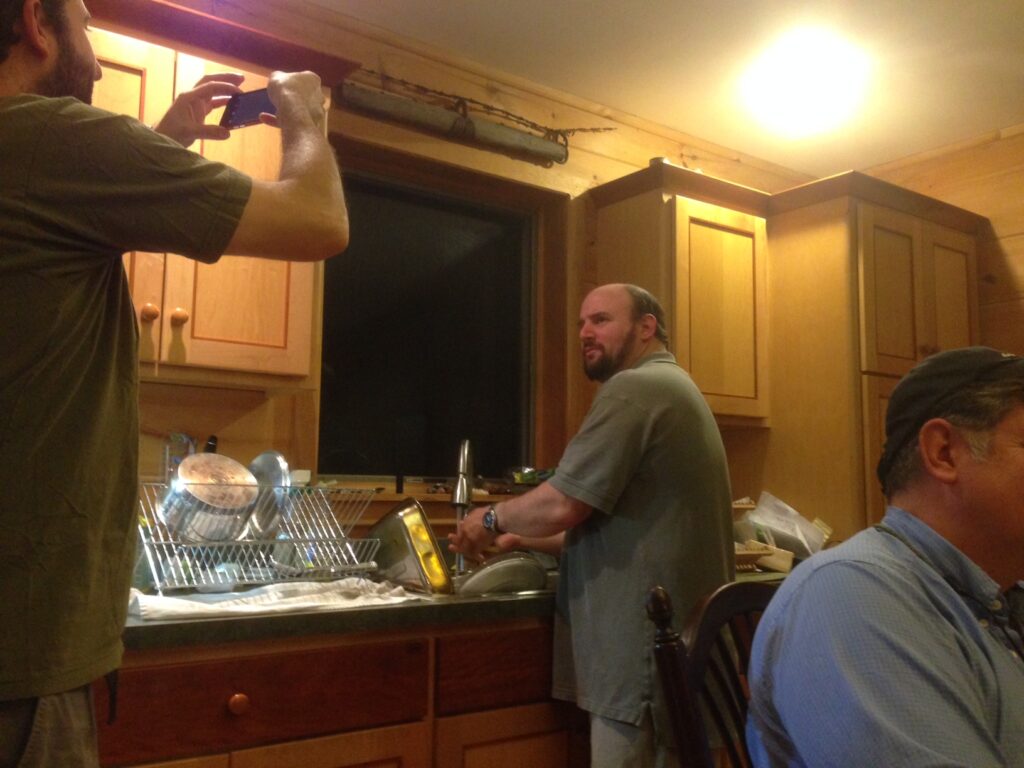
When one of our guys is finally browbeaten into washing dishes after years, it is cause for “Notify the media” acts like taking his unhappy picture. This is back in 2015. He still has to be browbeaten into washing the damned dishes

Lycoming County is the boot-looking shape in the northcentral area. Its northwestern corner is where we hunt. The darkest township there demonstrates the importance of organized hunting drives. A bunch of large hunting clubs are located in this area, and their members put on highly coordinated, obviously successful drives.
Good luck, bear hunters!
Bear rifle season is here in Pennsylvania, starting tomorrow morning, and in many rural places bear hunting has displaced deer hunting as the primary outdoor recreational activity.
Pennsylvania’a bear population is at an all-time (modern times) high, as demonstrated at least in my own small world by the large black bear that showed up a block from my Harrisburg City home last year. Or the other bear that showed up on the same street, but ten blocks closer to the down-town area, a few months later. When bears are showing up in major cities, you know their regular rural habitat is filled up, and the younger generations are looking for new homes.
So good luck to Pennsylvania’s bear hunters tomorrow through next Wednesday. Our own crew is half of the usual number, due to some guys fearing the CCP virus, and some others having health emergencies at home that prevent them from traveling. Normally we field guys from five states across the East Coast, and at one time, all the way from California. Last year we had a guy from England. Usually the cabin is packed and noisy, and this year it will be more subdued. Nonetheless, despite the challenges this year, we will still field a hunting crew. Some will be out tomorrow, some out Sunday, and some out the rest of the week.
Here in the hills, we have not seen bear sign for a long time, which is surprising. Our township here usually produces one of the highest bear harvests in the entire state. We shall see what happens, however, as hunters enter the woods and begin to push animals around. In places where no bears have been seen all year, there could well be a bunch running through.
Good luck to those who are hunting alone, with family, or with their usual chums. For me, this time together just cannot be missed. It comes just once a year, and is gone so quickly that you almost can’t believe it was here to begin with.
Be safe and have fun!
My comments to the PA Game Commission
The Pennsylvania Game Commission board of commissioners will be meeting this weekend, to set next season’s dates and bag limits. Like many other people, I submitted comments by email last week. From past experiences with this, I know that the commissioners read comments and requests from the public. Some of my comments, and those of my son, have received direct feedback from various members of the board.
A key to getting the commissioners to read and truly consider your comments is to submit them with plenty of time for the recipients to read them. If you submit comments a day or two before the meeting, it’s a very low likelihood of anyone having time to read them. Also, try to keep comments short, to the point, and sweet. Comments with prolonged bitching, whining, and playing biologist when you have no training or education or even a novice’s interest in wildlife biology, are all ways to ensure that your audience at best glances at your comments.
“Dear Commissioners,
Hunting should be fun, and therefore our small game seasons should run unbroken from their Fall opening to their February close. Whatever long gone reason for the on again-off again pattern of small game seasons, Pennsylvania must create opportunities for everyone. No biological reason exists for hiccup-style seasons. Few if any other states have this odd pattern. Let’s just let our hunters have fun and hunt.
In that vein, please consider allowing bodygrip traps on running pole sets in our most rural WMUs. The idea that a loose domestic dog is going to get caught in a trap in the middle of a state forest wilderness is preposterous. Same is true on private land. Same goes for allowing snares. We need all the tools we can get to manage coyotes. With now three years of crazy freeze-thaw-rain winter weather cycles, it’s impossible to rely on footholds. Cable restraints should be allowed throughout the whole season, and snares should be allowed on private land and or on public land in the Big Woods WMUs.
Finally, please put one of our Sundays on the day after the Saturday bear rifle opener, and another Sunday on the day after the Saturday deer rifle opener. This will create the most energy and excitement for our hunters. Even better, make bear and deer rifle concurrent!
Thank you for considering my thoughts,
–Josh”
It’s that time of year again, Pt. II
It is now “that time of year again,” but Part Two.
A month ago your firewood had better have been laid up and close to perfectly dry, or you were going to have an uncomfortably cold winter in rural America.
Now, a month later, a whole bunch of hunting seasons are upon us. Small game, trapping, deer archery, bear archery…and many people are afield a serious amount of time. Some people try to catch the deer rut in a couple different states with their bow. It can become a crazed time, where the humans are just as worn down and rutted up by the prospect of catching unawares a big old wary buck who, in his brief moment of annual craziness, lets down his guard.
Usually, I do not begin trapping in earnest until December, when all pelts are truly prime and when the bobcat and fisher seasons begin. Early on I set out cage traps to thin out the skunks and possums that will otherwise clog up my best sets later on. Never one to sell furs, trapping for me has always been about helping ground-nesting birds against an overabundance of nest-raiding mammals pulsing out from suburban sprawl habitats. With Russia and China in bad financial and economic situations the past five years, wild fur has not been in as big demand as the past. This lower demand has led many professional trappers to abandon their lines and wait for prices to come back up. In turn, that let-off in trapping pressure results in TONS of raccoons, possums, skunks etc running around. Over the past couple of weeks I have seen more road-kill raccoons than in many years past all together.
And this high population of raccoons means higher rates of rabies, trash-raiding, fights with pets, etc.
My favorite type of hunt is the solo wilderness excursion. Sleeping in a cold tent, bundled against the night time freeze, waking up to some snow on everything, enjoying a hot tea to start the day, and wandering into the wind, trying to find buck or bear tracks. Or in the case of a big male bear, making sure he isn’t on my track, like two years ago.
Is there danger in this? Sure. Then there is danger in being hit by a car, or falling and damaging a body part. There is danger in never experiencing life, and thinking that the modern risk-free cocoon most of us live in is either normal or healthy. It is neither.
And so it is that time of year again, when every fiber in my body says “Get outside, NOW!” It is a time of forgotten or deliberately misplaced professional obligations, phone calls returned on a Friday afternoon, instead of the prior Monday morning. I hope friends and colleagues will forgive me if I am a little late in getting back.
Nature is calling on the phone, it’s for me, and I gotta run.
I’ll be back. Promise.
PA deer hunters…spending 40 years in the desert
Last week, a guy in his late 50s posted a complaint on social media. He was both complaining about “not enough deer” to hunt in Pennsylvania, and also boasting about how he buys up as many doe tags as he can get, and then he tears them up, and then he uses them to file false deer harvest reports. He hopes this all will influence Pennsylvania’s science-driven deer management. One result of all this complaining by guys like this man is that the PA Game Commission is unable to get the license fee increase from the legislature that the PGC and most hunters want.
On the one hand, this self-defeating complaining and tearing up of doe tags is pretty much insane behavior, and a complete waste of one’s own precious time on Planet Earth.
On the other hand, that someone is so passionate about hunting and wildlife is a good thing. The question is, can this guy and the thousands of other unhappy hunters like him be educated about scientific deer management? Or are they so close-minded and emotional about this subject that they are immune to empirical evidence, logic and reason?
One result of our state’s scientific wildlife management is that we are now a major trophy hunting destination. Previously unthinkably enormous bucks and gigantic bears are within reach of those who are willing to hunt hard and smart. Bucks that rival and surpass those of the “best” whitetail states in the Mid-West. Black bears that are as big as Alaskan grizzlies. These are tangible signs of policy success, and that Pennsylvania is now an outdoor Promised Land after decades of hunters being happy with a pathetic forkhorn or even a spike buck.
On my westward drive along I-80 last week, and my drive south yesterday, from northwest Lycoming County down to Dauphin County, I saw dozens of dead deer littering the sides of the roads. Actually there were so many that I lost count. There may have been a hundred dead deer along the roads. Including along very rural roads in areas where many older guys complain there “ain’t no deer.” Obviously there are a lot of deer in these places, because they are not all being killed on the highway. These dead deer are the fruit of deer-car collisions, a very expensive and dangerous result of an overabundant deer population.
To be fair to the complaining hunters, the PA deer population in these places may be too high for the road system and not high enough for hunters’ desires. That is a very real possibility. It may be that the Pennsylvania road system is just too big, too widespread into rural areas, to allow many deer to survive into the Fall hunting season.
No, we are not going to shut down the public roads to stop the carnage, though it would make sense for Pennsylvania to put a moratorium brake on road building. We taxpayers cannot afford the operations and maintenance costs on the roads and bridges we have now, let along on any new roads and bridges. PennDot must re-direct its energies into safely maintaining the infrastructure we already have, like how about wildlife tunnels? And if the deer-car collisions are any indication, our public road system has been poorly planned and badly implemented; it has spiderwebbed out into the most rural areas and wildlife habitats. Thereby inviting expensive car collisions with wildlife.
I think this unhappy hunter situation is going to be like the ancient Hebrews’ 40 years in the desert. The older generation that cannot adapt to changing habitat, changing deer behavior, changing land use patterns and changing hunting methods is going to have to die off. Then the younger generation can get in the driver’s seat on deer management policy.
The younger generation understands and values science and biology in setting policy, like doe harvest tags, the crucial importance of getting buy-in and acceptance from the larger society around us (people unhappy about hitting overabundant deer; in Europe hunters are personally responsible for keeping wildlife populations at safe levels), the need to be multifaceted and flexible when hunting deer, etc. These complaining hunters represent the ex-slave mentality of those Hebrews who left Egypt and who could not learn to live as free men. Moses could not let them enter the Promised Land because they would infect everyone with foolish ideas and weakness. That would put the entire effort at risk. So he kept them wandering until that generation died out.
Sorry, old complaining guys, you are living in a broken past. You are slaves to an unproven, non-scientific, failed approach to wildlife management. If you cannot change your mindset and embrace reality, then you will be remembered as the lost generation that stood in the way of success and happiness.
And to be fair, this same broken thinking has haunted the Pennsylvania Farm Bureau’s approach to Sunday hunting. The older generation there has successfully blocked a 50% increase in hunting opportunity for decades, just because they think it is “wrong,” for no good, defensible reason. But that also is about to change, soon, as the fed-up younger generation of farmers, including religious Mennonites, takes this important policy issue in hand and directly bucks the older guys standing in the way of family success and happiness.
To enter the Promised Land, you must shed your slave mentality. I hope the anti-science hunters and the anti-freedom PA Farm Bureau folks will join us as we enter a glorious new period in Pennsylvania’s outdoor heritage.
Our Wildlife Management Comments Submitted to the PA Game Commission
Dear PGC Commissioners,
In so many ways the Game Commission is on an exciting path, really moving forward on policy, staff culture, and scientific wildlife management. It is an exciting time to be a hunter and trapper in the great state of Pennsylvania, thanks to you. Hunting and trapping are supposed to be fun, and the PGC should be able to maximize opportunities without sacrificing the natural resource base. If anything, the agency has been perhaps too conservative, too cautious. In that vein, here are some small suggestions for improving hunting and trapping in Pennsylvania:
a) Make all small game seasons concurrent, start them in late September or early October and run them unbroken until mid February. The current on-again-off-again schedule is silly, an artifact from many decades ago. Our current small game hunting schedule leaves kids and oldsters alike out in the cold with nothing to hunt if they can’t get to deer camp, or if they do kill a deer and want to keep on hunting. Hunters deserve maximum opportunities that do not degrade or put wildlife populations at risk, and adding a few extra days won’t hurt anything, but they will help hunters tremendously. Put another way, the risk of changing this is very low to non–existent, and the benefits are huge. Well, what is the risk, really?
b) Allow the use of snares in rural WMUs and/or on private lands. Cable restraints are an important trapping tool under any circumstances, and especially so as we experience ever-increasing freeze-thaw-freeze-thaw winters, with rain no less. These weird winter conditions render traditional footholds nearly useless both early and late in the season. Cable restraints can function better than footholds under those conditions, but they just are not sufficient for the big coyotes we are encountering. Getting coyotes into cable restraints is tough enough, and holding them there is even tougher. Chew-throughs of our cables are common, where a snare would positively catch the coyote and hold it, bringing it to hand and into the bag. In rural areas (or on private land) there is a far lower expectation or risk of a pet or feral dog or cat being caught. We are ceding too much to the anti-trappers by prohibiting snares where they can do the best good. A pet is an animal that lives in a home. Eliminating a very useful tool because of some vague or low-probability worry is not good policy. We can do better, and snares are much better than cable restraints in general, and particularly in the northern Big Woods areas. Also, CR certification can only be done right in person, through hands-on training. This online certification is going to lead to problems, especially where CRs are used like snares.
c) Allow the use of body-grip (Conibear) traps outside water courses, specifically on running-pole sets for fishers, bobcats, and raccoons. Like the snare situation above, our trapping regulations are unrealistic, they are too conservative, penalizing law-abiding trappers because of vague fears that under reasonable circumstances will not happen. Securing body-grip traps up off the ground is well out of the reach of dogs and domestic cats. Separately, if a pet owner lets their animal out the door to run free, where it can trespass, be hit by a car, be eaten by a coyote or fox or hawk, or get hurt in a fight with another animal, then they do not truly care about it and it is not a real “pet.” Pennsylvania trappers do not deserve to be hurt because of others’ irresponsible behavior. Elsewhere in America, the use of bodygrips on running pole sets is very effective and humane. We can stick with the #160 size as the maximum.
d) Extend the fisher trapping season and areas. Trappers in Berks and Lebanon Counties have told me of catching fishers in their sets, and we are seeing them in Dauphin County. There is no good reason why we cannot extend where and when we trap these abundant predators. Incidentally, they eat bobcats and turkeys, and it would be silly to expect fishers to simply harmoniously co-exist with other animals. They are a voracious predator and they will have a disproportionate impact on predator and prey populations alike if allowed to expand unchecked. Fishers are cool animals and I am all for having them in our ecosystems. What is lacking now are the mountain lions and wolves that in the distant past would have eaten them, and kept them in balance with other wildlife. We humans now fulfill the role of lions and wolves. Let us at ’em.
e) Make sure bobcat populations can sustain these long trapping and hunting seasons. We are seeing a lot less bobcat sign and fewer bobcats on our trail cameras. This was the first year we did not get a bobcat through either trapping or calling in 2G and 4C, and while this may be just our observation, we are concerned. If bobcat harvests must be reduced, then we prefer that it come out of their hunting season. There is a ton of hunting opportunities in Pennsylvania, and not a lot of great trapping opportunities. Heck, muskrats are practically extinct, coyotes have eaten most of the red fox in the southcentral, and possums are clogging nearly every trap. Let us keep our bobcat trapping intact.
f) Reinstate concurrent buck and doe deer hunting. We are seeing a high number of deer nearly every place we hunt (WMUs 2G, 4C, 3A, 5C, 5D). Deer populations are definitely lower than in 2001, and deer are harder to hunt now than then, but the quality is unbelievable, and the herd can sustain both doe and buck hunting. Pennsylvania is now a real trophy destination, so keep up the scientific management, which would include allowing hunting on Christmas Day.
g) Expand the bear season by one day in WMUs 2G and 4C, or rearrange the season entirely. There are an awful lot of bears everywhere, especially in 2G and 4C. On the Friday before bear season starts, we see loads of bears having tea and crumpets in the back yard. They are watching football and hanging out leisurely in reclining chairs. Come Opening Day through Wednesday, we might see the hind end of a bear or two, or we might occasionally harvest a bear, if we work hard enough. By deer season opening day the following week, the bears are back to having tea and crumpets in the back yard, hardly disturbed by all our hunting efforts. Another way to address this is to make bear and deer seasons concurrent, at least for one week, and perhaps start that concurrent season the week of Thanksgiving.
h) Do more to end wildlife feeding. We continue to see mangy bears, and deer baiting under the guise of “helping” wildlife through artificial feeding. It’s not good for the animals, and can actually be bad. People also feed wildlife to entice game animals away from (other) hunters. This is a cultural practice that PGC needs to do more to end, through education and enforcing the bear feeding regulation.
Thank you for considering our comments. We do love the PGC and admire your field staff, especially.
Josh and Isaac First (father and son)
Harrisburg, PA
Bear and Deer Seasons in the Rearview Mirror
The old joke about Pennsylvania having just two seasons rings as true today as it did fifty years ago: Road construction season in the Keystone State seems to be a nine-month-long affair everywhere we go, a testament to how not to overbuild public infrastructure, if you cannot maintain it right.
And the two-week rifle deer season brings out the passion among nearly one million hunters like an early Christmas morning for little kids (I doubt the Hanukkah bush thing ever took off). All year long people plan their hunts with friends and relatives, take off from work, spend lots of money on gear, equipment, ammunition, food, and gas, and then go off to some place so they can report back their tales of cold and wet and woe to their warmer family members at home. These deer hunts are exciting adventures on the cheap. No bungee jumping, mountain cliff climbing, jumping through flaming hoops or parachuting out of airplanes are needed to generate the thrill of a lifetime as a deer or bear in range gives you a chance to be the best human you can be.
Both bear and deer seasons flew by too fast, and I wish I could do them over, not because I have regrets, but because these moments are so rare, and so meaningful. I love being in the wild, and the cold temperatures give me impetus to keep moving.
One reflection on these seasons is how the incredible acorn crop state-wide kept bear and deer from having to leave their mountain fortresses to find food. Normally animals must move quite a bit to find the browse and nuts they need to nourish their bodies. Well, not this year. Even yesterday I was tripping over super abundant acorns lying on every trail, human or animal made.
When acorns are still lying in the middle of a trail in December, where animals walk, then you know there are a lot of nuts, because normally those low-hanging fruits would be gobbled right up weeks ago.
After still hunting and driving off the mountain I hunt on most up north, it became clear the bear and deer were holed up in two very rugged, remote, laurel-choked difficult places to hunt. Any human approach is quickly heard, seen, or smelled, giving the critters their chance to simply walk away before the clumsy human arrives. All these animals had to do was get up a couple times a day, stretch, walk three feet and eat as many acorns as they want, and then return to their hidden beds.
This made killing them very difficult, and the lower bear and deer harvests show that. God help us if Sudden Oak Death blight hits Pennsylvania, because that will spell the end of the abundant game animals we enjoy, as well as the dominant oak forests they live in.
The second reflection is how we had no snow until Friday afternoon, two days ago, and by then we had already sidehilled on goat paths, and climbed steep mountains, as much as we were going to at that late point in the season. With snow, hunting is a totally different experience: The quarry stands out against the white back ground, making them easier to spot and kill, and snow tracking shows you where they were, where they were going, and when. These are big advantages to the hunter. Only on Friday afternoon did we see all the snowy tracks up top, leading over the steep edge into Truman Run. With another two hours, we could have done a small push and killed a couple deer. But not this year. Maybe in flintlock season!
And finally, I reflect on the people and the beautiful wild places we visited.
I already miss the time I spent with my son on stand the first week. He was with me when I took a small doe with a historic rifle that had not killed since October 1902, the last time its first owner hunted and a month before the gun was essentially put into storage until now.
And then my son had a terrible case of buck fever when a huge buck walked past him well within range of his Ruger .357 Magnum rifle, and he missed, fell down, and managed to somehow eject the clip and throw the second live round into the leaves while the deer kept moseying on by. When I found my son minutes later, he was sitting in a pile of leaves where the deer had stood, throwing the leaves around and crying in a rage that we needed to get right after the deer and hunt them down. The boy was a mess. It was delightful to watch.
I miss the wonderful men I hunted with, and I miss watching other parents take their own kids out, to pass on the ancient skill set as old as humankind.
It is an unfortunate necessity to point out that powerline contractor Haverfield ruined the Opening Day of deer season for about three dozen hunters by arriving unannounced and trespassing in force to access a powerline for annual maintenance in Dauphin County. We witnessed an unparalleled arrogance, dismissiveness, and incompetence by Haverfield staff and ownership that boggles the mind. I am a small business owner, and I’d be bankrupt in three days if I behaved like that. Only the intervention of a Pennsylvania Game Commission Wildlife Conservation Officer saved the day, and that was because the Haverfield fools were going onto adjoining State Game Lands, where they also had no business being during deer season.
Kudos to PPL staff for helping us resolve this so it never happens again.
Folks, we will see you in flintlock season, just around the corner. Now it is time to trap for the little ground predators that raid the nests of ducks, geese, grouse, turkey, woodcock, and migratory songbirds. If you hate trapping, then you hate cute little ducklings, because the super overabundant raccoons, possums, skunks, fox, and coyotes I pursue eat their eggs in the nests, and they eat the baby birds when they are most vulnerable.
Small success stories come in big, snoring packages
Sitting at lunch today with someone in his late 60s, we reminisced about how sparse bears and turkeys were 40 years ago in central Pennsylvania.
We also recalled how pheasants were in our back yards every morning, forty years ago, and how sad it is that they are now gone, victims of abundant raptors, foxes, coyotes, skunks, possums, raccoons, and loss of traditional farmland edge habitat.
Doug remarked that pheasants are not a native species, and that as much as he enjoyed hunting these colorful, beautiful birds, if he had to make a trade-off, he is happy with the outcome of surplus bears and turkeys.
While I wish I could have it all ways – abundant wildlife of all types, I agree with Doug.
Just to drive home how successful Pennsylvania’s bear conservation program has been, a friend texted me yesterday to say that the bear I had found sleeping under a log on his farm on the southern Lower Paxton Township line three weeks ago is still snoring away there. He has set up a couple trail cameras around it to monitor its movements. Although we did not hear any squeals of little newborn bear cubs then or this week, and we do not know its sex, it may have since given birth. That long stay in that one place could be pregnancy, and would account for how long the bear has remained in the scraped out den-nest it made for itself.
What is amazing is that this deeply snoring bear is literally on the edge of suburbia. Well, it is actually deep into suburbia, in a relatively small island of open space. Think about it this way: Bears used to be a symbol of wild places. Now, they are often suburban dumpster divers. That speaks well to the large population of bears still inhabiting the truly wild areas away from suburbia. That original population of deep forest and mountain dwellers is obviously in very good health.
And on that same farm there are now roving bands of wild turkeys, something not seen since the mid-1800s, when wild turkeys were literally all eaten up in this region.
Conservation success stories are abundant, and here we have two – bears and turkeys. We cannot take these wins for granted, however; we must safeguard what has been accomplished. I hope that the Wolf Administration soon appoints the new Sportsmen’s Advisor. That is a unique leadership position Pennsylvania can not afford to leave vacant.
Why deer hunting is good for the environment
This past week was the early muzzleloader season in Pennsylvania. Instead of the modern inline muzzleloaders, I use an old fashioned flintlock. It is more challenging, and honestly, it’s just plain beautiful to look at.
Up at a relatively small piece of land I’ve been cultivating for twelve years, this fall marked the first time I’ve seen young oak seedlings survive deer browsing. Across the forest floor a plethora of oak seedlings – white, red, chestnut – create a carpet effect that indicates a future of young oak trees….if they can avoid being eaten by deer.
While I was casually walking through the forest, I saw a young doe looking at me. I raised the gun and fired. I will take any opportunity to help the little oaks become big oaks. They do, after all, produce the acorns necessary to feed deer, bears, turkeys and many other wild animals.
Then as if on cue, one of my very next steps was right into an enormous pile of bear poop. Colored brown from all the acorns, this fresh pile represents a great modern conservation success story, Pennsylvania’s population of huge black bears.
How ironic that deer can eat the trees needed to feed both themselves and their predators, the bears. How ironic that humans, who have dramatically shaped our planet over the past 20,000 years, do all we can to help an animal that might want to eat us (the bear), due to our recreational desires, and in doing so eat the deer sought by the bear.
Life is intertwined. Our futures are intertwined, humans and wildlife. Deer hunting is good, and good for the environment.
